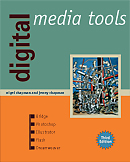
See the book at amazon.co.uk or amazon.com
Related Books

See Digital Multimedia at amazon.co.uk or amazon.com

See Web Design: A Complete Introduction at amazon.co.uk or amazon.com
The authors are not responsible for the content of any external sites linked to from digitalmediatools.org
All material on this site is ©2007–2010 MacAvon Media and may not be reproduced without permission.
Flash Hints and Tips
Insert Keyframe
Insert Keyframe is currently on a third-level menu: Insert>Timeline>Keyframe. This is very annoying if you need to insert keyframes often. We haven’t tried this on Windows, but on a Mac you can still use the F6 function key as a shortcut to insert a keyframe. Just make sure you have the previous keyframe selected on the right layer in the timeline and hit F6. This shortcut is not documented in Flash CS3.
Exporting Hidden Layers
Are you going mad because hidden layers in your Flash document are showing up in the final SWF? You may well find that Flash is doing this by default, but it’s easily corrected. Open the Publish Settings dialogue (use the File>Publish Settings… command) and choose the Flash tab. Under Options you will see a checkbox for Export hidden layers – untick this unless you want your hidden layers to show in your final movie.
Movie not Looping?
If your find that your movie is not looping and it should do, select the HTML tab under the Publish Settings (see the tip above) and check whether the Loop checkbox is ticked under Playback (about half-way down the dialogue).
Creating Motion Tweens
Whether you use menu commands or the Properties panel to create a motion tween, it is vital that you click on a frame in between your two end keyframes before you create the motion tween. The most common reason for motion tweens failing to appear is that one of the end keyframes is selected at the time that the Properties panel or Insert menu is used to try to create the tween. As the last thing you normally do before creating a tween is work on its end keyframe, it is very easy to overlook the fact that this keyframe is still selected.
Adjusting Position of Imported Images
If you import a sequence of images (such as PSD or AI files) you may very well find that Flash has failed to position them correctly on the Stage. The position can be corrected by selecting an image and setting the X and Y coordinates in the Properties panel (usually both to 0, if you want to align to the top left-hand corner of the Stage). This is simple for a single image, but if you have imported a long sequence of images then you don’t want to position each one individually. In this case, you should use Edit Multiple Frames to reposition all the images at once. Turn on Edit Multiple Frames in the Timeline by clicking the third icon from the left with two overlapping squares, at the bottom left of the Timeline (roll the cursor over for a Tooltip if you are not sure which icon is which). Then stretch out the Onion Skin Marker at the top of the Timeline to cover all of the frames you want to move. Finally, make sure you are on the correct layer, and Select All (all the frames you want to move should turn black in the Timeline). Now if you set the correct coordinates for the top left-hand corner of your images in the Properties panel it will reposition them all at once. But don’t forget to turn Edit Multiple Frames off again once you have finished …
Current Frame
![]() The current frame indicator — the little red box above the timeline — shows you where the current frame is on the timeline. If you need to know the current frame's number, you can find it underneath the timeline, between the Modify Onion Markers icon and the frame rate. To the right of the frame rate, the elapsed time to the current frame is shown.
The current frame indicator — the little red box above the timeline — shows you where the current frame is on the timeline. If you need to know the current frame's number, you can find it underneath the timeline, between the Modify Onion Markers icon and the frame rate. To the right of the frame rate, the elapsed time to the current frame is shown.
Remember that the current frame is not necessarily selected.
Lock Your Layers
It can be quite easy to end up where you don’t expect to be when working on a multi-layer document in Flash, especially as the current frame in the Timeline is not selected by default. You can’t protect yourself entirely against altering the wrong frame, but do lock any layers you are not actively working on. This helps you avoid making changes where you don’t intend to.
The Solid Red Rectangle
We’re not saying that this will happen to you, but if you do ever see the Stage turn to a solid red rectangle unexpectedly it is probable that you have hit a serious problem in Flash and will not be able to back out of it. In this case we have found that the only thing to do is to Close without saving. This is annoying, but better than ending up with a corrupted file. It is always prudent to save frequently, and – if you want to be extra careful and are working on a big project – save different copies at different stages.